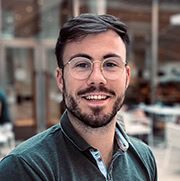Join us as IASP’s Early-Career Network highlights the path to publication in PAIN for three exceptional early-career researchers, and the impact of those publications on their career.
Date: Tuesday, September 17, 10:00 a.m. to 11:00 a.m., Eastern (US) Time
The mission of IASP’s Early Career Network (ECN) is to support, advance, and promote the needs of early-career members and to prepare them to be the future leaders of IASP and experts in pain research and management. To fulfill its mission, the ECN provides opportunities to network, collaborate, and share experiences, as well as organize mentoring programs, in-person events at conferences, and learning sessions – such as webinars.
In this webinar, the ECN will showcase examples of exceptional research published in IASP’s pre-eminent journal PAIN over the past two years, as evidenced by their designation as Editor’s Choices. In particular, this webinar will focus on each participant’s individual journey to publication (highlighting important lessons learned), and the impact of each publication on their careers.
Participants include:
- Hannah Gennis, PhD, Hospital for Sick Children, Toronto, Ontario, Canada
Understanding the concurrent and predictive relations between child-led emotion regulation behaviors and pain during vaccination in toddlerhood - Gabriel Reigner, University of California San Diego, USA
Disentangling self from pain: mindfulness meditation-induced pain relief is driven by thalamic-default mode network decoupling - Allison Barry, DPhil, University of Oxford, UK
Deep RNA-seq of male and female murine sensory neuron subtypes after nerve injury - Guillermo Ceniza Bordallo, Complutense University of Madrid, Spain (host)
About the Presenters
Hannah Gennis, PhD
 Hannah is a clinical and health psychologist working in the Eating Disorders Program at the Hospital for Sick Children in Toronto, Ontario, Canada. She received her master of arts and PhD in clinical-developmental psychology at York University in Toronto, Canada, where she completed her research in the Opportunities to Understand Childhood Hurt Laboratory under Rebecca Pillai Riddell’s supervision. Hannah’s research focused on early childhood pain-related distress, notably how caregivers support infants to regulate their pain during routine vaccinations, as well as how children’s own regulatory strategies during vaccinations develop in toddlerhood. Her graduate research has been published in several high-impact journals, including her dissertation work being selected as an Editor’s Choice in PAIN.
Hannah is a clinical and health psychologist working in the Eating Disorders Program at the Hospital for Sick Children in Toronto, Ontario, Canada. She received her master of arts and PhD in clinical-developmental psychology at York University in Toronto, Canada, where she completed her research in the Opportunities to Understand Childhood Hurt Laboratory under Rebecca Pillai Riddell’s supervision. Hannah’s research focused on early childhood pain-related distress, notably how caregivers support infants to regulate their pain during routine vaccinations, as well as how children’s own regulatory strategies during vaccinations develop in toddlerhood. Her graduate research has been published in several high-impact journals, including her dissertation work being selected as an Editor’s Choice in PAIN.
Gabriel Reigner
 Gabriel is a PhD student in data science at the University of California San Diego, USA, and achieved a bachelor’s degree in neuroscience from the University of Southern California, USA. He has contributed to research in pain neuroimaging and now focuses on brain imaging statistics, including developing new analysis methods and open-source software.
Gabriel is a PhD student in data science at the University of California San Diego, USA, and achieved a bachelor’s degree in neuroscience from the University of Southern California, USA. He has contributed to research in pain neuroimaging and now focuses on brain imaging statistics, including developing new analysis methods and open-source software.
Allison Barry, DPhil
 Allison has a research background in sensory physiology and bioinformatics – having achieved her DPhil at the University of Oxford, UK, with David Bennett and Georgios Baskozos – looking at the molecular profiling of murine primary afferents in neuropathic pain. Allison currently splits her time with the University of Vienna, Austria, and University of Texas at Dallas, USA, using multi-omic methods to understand pain.
Allison has a research background in sensory physiology and bioinformatics – having achieved her DPhil at the University of Oxford, UK, with David Bennett and Georgios Baskozos – looking at the molecular profiling of murine primary afferents in neuropathic pain. Allison currently splits her time with the University of Vienna, Austria, and University of Texas at Dallas, USA, using multi-omic methods to understand pain.
About the Host
Guillermo Ceniza Bordallo
 Guillermo is a predoctoral researcher at Complutense University of Madrid in Spain, having previously graduated with a bachelor’s degree in physiotherapy and a master’s degree in health sciences research with honors. His research focuses on unraveling the mechanisms underlying persistent pain in the pediatric population following surgical procedures, specifically chronic postsurgical pain. Guillermo’s work is driven by his passion for understanding pain-related behavior and the complex neurophysiological pathways involved in chronic pain. He’s received several awards for his research, including competitive national funding. Additionally, Guillermo is interested in science communication and the transfer of scientific knowledge, actively engaging in efforts to make complex scientific concepts more accessible to the public and ensuring that research findings are effectively communicated to both clinical practitioners and the wider community.
Guillermo is a predoctoral researcher at Complutense University of Madrid in Spain, having previously graduated with a bachelor’s degree in physiotherapy and a master’s degree in health sciences research with honors. His research focuses on unraveling the mechanisms underlying persistent pain in the pediatric population following surgical procedures, specifically chronic postsurgical pain. Guillermo’s work is driven by his passion for understanding pain-related behavior and the complex neurophysiological pathways involved in chronic pain. He’s received several awards for his research, including competitive national funding. Additionally, Guillermo is interested in science communication and the transfer of scientific knowledge, actively engaging in efforts to make complex scientific concepts more accessible to the public and ensuring that research findings are effectively communicated to both clinical practitioners and the wider community.


